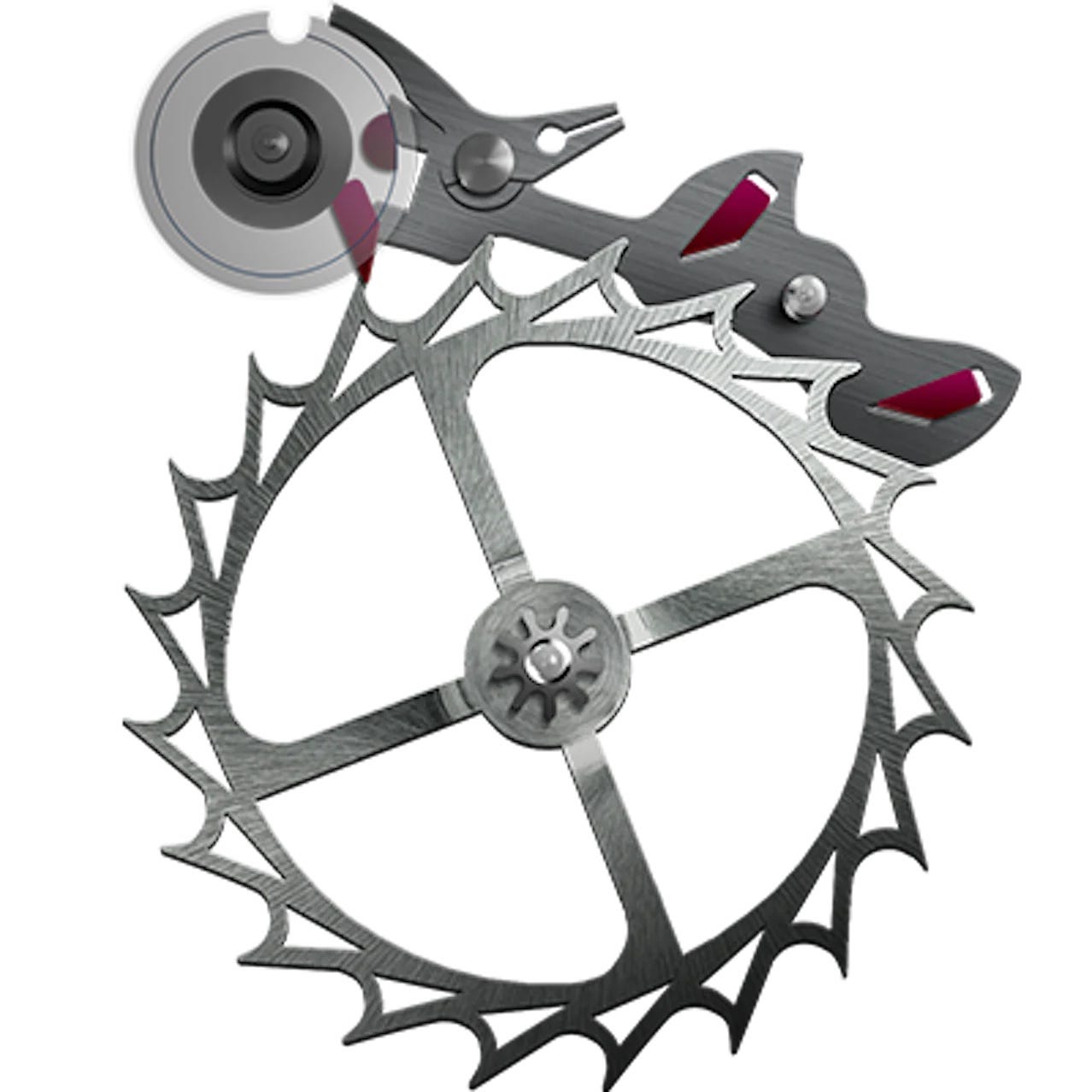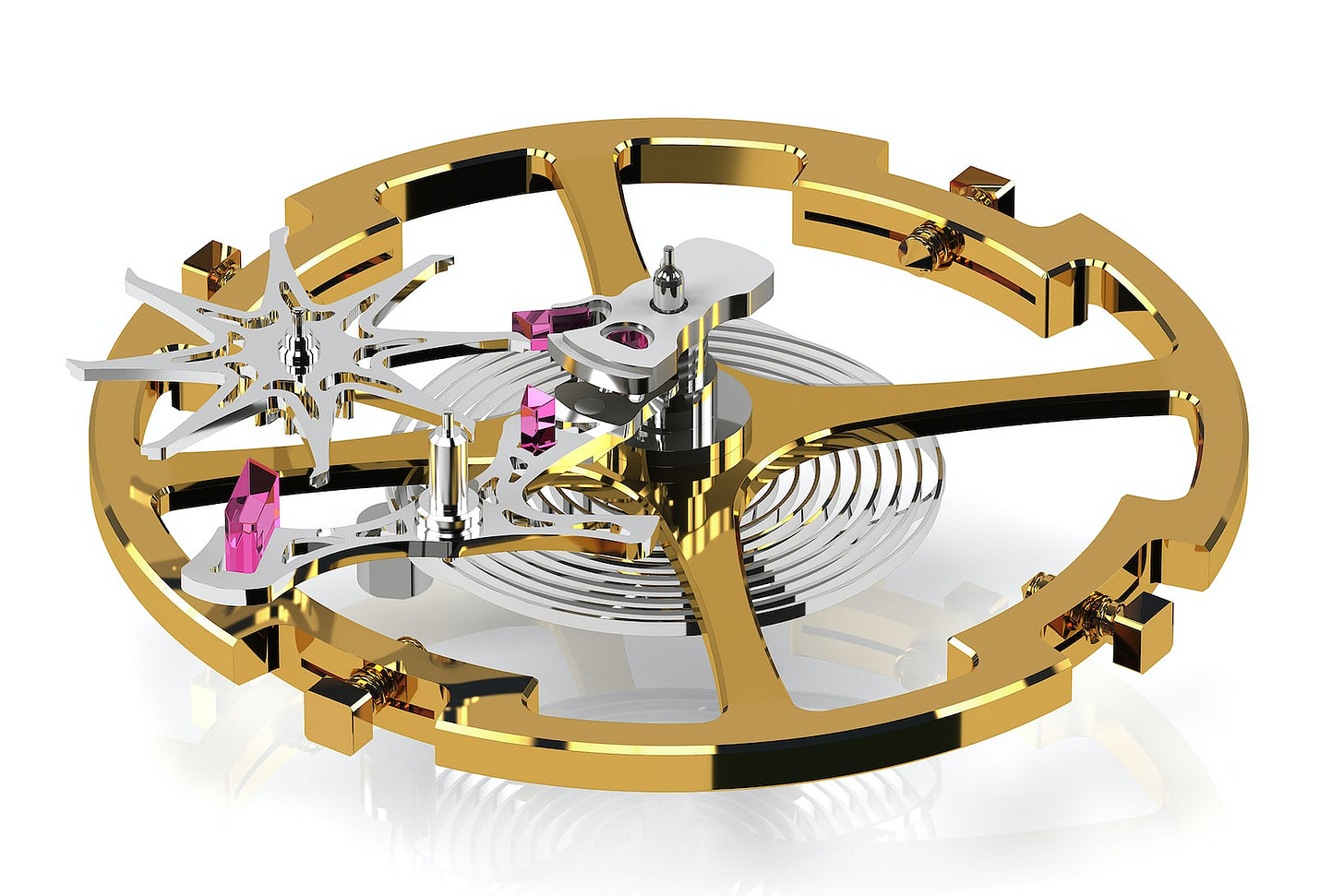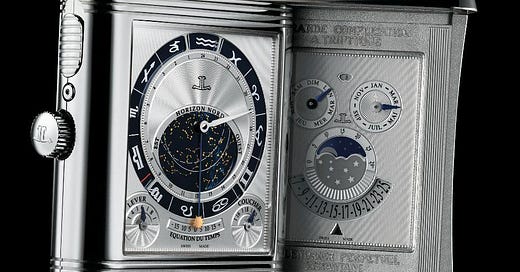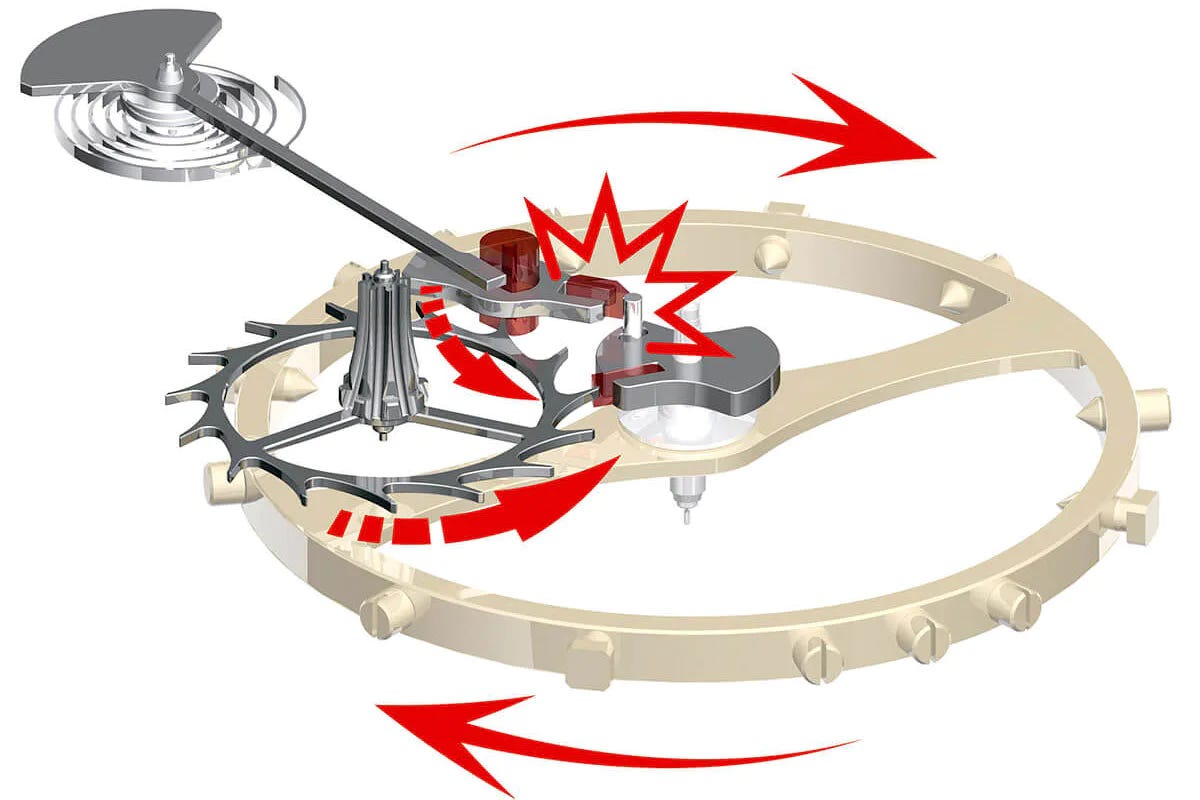Dude, Where's My Escapement?
Why is the lever escapement (with one major exception) still the only game in town?
Not long ago, I happened to run across a pretty mind blowing watch in WatchBox’s inventory – the Reverso Grande Complication à Triptyque, which I covered in my regular A Watch A Week column. The watch is a remarkable example of the wave of super complicated watches which were more or less de rigueur for any fine watchmaking brand in the mid-2000s (this was when the hot news from Cartier were its exotic super-complications in the Fine Watchmaking collection). It was the first Reverso to use both sides of the swiveling case, as well as the upper side of the case carrier, to show information – quite an incredible complicated watch, with a tourbillon, star chart, sunrise and sunset complications, and on the upper face of the carrier, a full instantaneous perpetual calendar rather ingeniously updated once a day at midnight via a pin extending from the swiveling case into the carrier. The only way you could screw that one up, is if you somehow happened to have the swiveling case unlocked from the carrier at midnight. The watch is one of those I would have liked to wear full time for a year, or two, or three, just to see how it was to look down at a watch and see an exact picture of the stars overhead and the exact position of the Sun in the Zodiac but as someone once wrote in a very different context, I have had to be content with what I have.
The one feature of the watch, which came out in 2006, that I had completely forgotten about until I wrote it up for WatchBox, was the escapement. This escapement was not the standard Swiss lever, not by a long shot. Instead it was something that JLC called the Ellipse Isometer Escapement, which was … well, here’s an image Jaeger-LeCoultre provided a million years ago of the escapement and its action.
The picture is confusing at first because it’s a view of the underside of the balance, escape wheel and escapement. The action is pretty simple though. The escape wheel impulses the balance in one direction only and there is a small detent which is held in place during locking by the spiral spring-loaded lever at the upper left. The whole idea behind this escapement is a very old one – you want to have impulse delivered directly to the balance, with no sliding friction, so you don’t need any lubrication at the impulse surfaces (gradual deterioration of such lubricants contributes to a gradual deterioration in precision, at least theoretically).
The whole rationale for the Ellipse Isometer Escapement is the same as for the co-axial, Fasoldt, Robin, AP direct impulse escapement, and probably a whole host of others – you want the escape wheel to deliver power to the balance directly, not through an intermediate lever, and you don’t want the escapement to require oil. The ideal escapement in a lot of ways is the chronometer detent escapement which was, no surprise here, developed for marine chronometers and sometimes used in pocket watches. It delivers impulse directly to the balance via the escape wheel, and requires no lubrication but it is not self-starting and it is also kind of delicate; it can be unlocked accidentally by a fairly minor shock, and so its use was mostly confined to marine chronometers and observatory watches (companies like Patek and Vacheron would sometimes do bespoke precision pocket watches for customers who were especially obsessed with accuracy).
The lever escapement on the other hand, is self-starting and if set up correctly, will not unlock accidentally but you need oil on the impulse surfaces at the interface of the lever pallets and the escape wheel.
The ideal escapement would have certain characteristics. The purpose of any escapement is twofold; to impulse the oscillator, and to count the oscillations. A perfect escapement would give impulse to the oscillator instantaneously at exactly the neutral point of the oscillation – the moment for instance when a pendulum is exactly vertical. There is no such thing, of course. There is no such thing as instantaneous transfer of energy because in the real physical world, transmission of energy takes place over time, even if the time in question is very brief. Moreover since no escapement is perfectly instantaneous every escapement will tend to cause the oscillator to either gain or lose on its rate. A perfect escapement would also lose no energy to friction, would be self-starting, and would also be perfectly immune to unlocking accidentally. It would also be completely efficient. Clearly such a thing has never existed nor will it ever exist. But the idea is to try and get as close as you can.

Escapements, thanks to the essential role they play, have fascinated watchmakers for many years and there are hundreds of different designs. A new book, “Les échappements en horlogerie mécanique - Histoire des multiples solutions apportées à un seul problème” by Oliver Laesser, runs to 446 pages and lists around two hundred different escapements; in 1913, Charles Gros catalogued 214. Yet the history of watch and clockmaking is dominated by just a few – the verge, detent, lever, and cylinder escapements in watches and variations on the anchor escapement in clocks. There are some modern makers who use true alternatives to the lever – Ulysse Nardin for one; F. P. Journe for another – but even these tend to be based on earlier work (Breguet’s echappement naturel, for instance). The only alternative escapement to gain widespread use in watches other than the lever, is the co-axial escapement, which is only in use by Omega, and by Roger Smith.

The appetite for experimenting with escapement design seems very low these days, I think partly because most of the new ones introduced over the last twenty or so years have struggled to offer any real advantage over the lever. There have been some experiments with flexible silicon escapements, from Zenith, Parmigiani Fleurier, and Girard Perregaux, but all three of these makers seem to have decided that the game was not worth the candle.
The problem is that the lever escapement has been around ever since Thomas Mudge made the first one in 1750, and while it is ingenious in a lot of ways, its many idiosyncrasies are very well known at this point and you can make, as Rolex does, mass produced watches to the tune of millions a year that run within chronometer specs or better. Lower friction escapements like the co-axial ought to produce longer service intervals and better rate stability but the co-axial does not get you off the hook when it comes to oils and greases aging elsewhere in the watch, and of course, seals and gaskets need to be regularly replaced. Omega’s recommended service interval is four to five years; Rolex recommends ten years and its watches are powered by a variation on the lever escapement virtually identical to the classic Swiss lever, except for variations in the lever geometry to produce better efficiency. Seiko has introduced a direct impulse escapement however its primary advantage seems to be better efficiency and a longer power reserve.

The watch industry is first and foremost a business, and with very few exceptions there is no percentage in adopting a new escapement, or trying to improve on an existing one; escapements are expensive and time-consuming to develop and unless you need one as a point of differentiation from the competition (the best argument for Omega having adopted the co-axial) or because its important to experiment with escapement designs because your company is intellectually committed to doing so (Roger Smith) the incentive to come up with and industrialize a really novel escapement is extremely low. The reality of course is that the real paradigm shift in portable precision timekeeping started in 1960 with the invention of the Accutron and was completed in all the basics in 1969, with the advent of quartz watches and today, the most precise watch in the world is the Citizen 0100, which has a maximum deviation in rate of ±1 second per year – unlikely to be beaten in the foreseeable future, and certainly not by anything with a conventional balance and escapement.
You could if you are a fan of innovation in mechanical horology, find all this a little depressing. But there is something rather astonishing and amazing about the fact that as far as the escapement goes, there is nothing in a modern watch that would not be instantly comprehensible to a watchmaker from nearly three hundred years ago. I can’t think of a single other mechanical invention which has proven so resilient and so useful for so long. When Mudge invented the lever, 273 years ago as of this writing, the Industrial Revolution was in its infancy (depending on who you ask; some historians say that in 1750 it hadn’t begun at all). The Watt steam engine was still a quarter century off; sailing ships were the last word in transportation technology; the first working steam locomotive was fifty years away. Medicine bore almost no resemblance to its practice today (in 1847 Ignaz Semmelweis had his professional credibility destroyed for having the nerve to suggest that doctors washing their hands once in a while might not be a bad idea). Virtually nothing from the era survives as a ubiquitous mechanical solution to a practical problem and yet the lever ticks on, as reliably now as ever, in tens of millions of watches around the world – a battery-free, purely mechanical, minor – maybe not so minor – miracle of mechanical engineering. Pour one out for Thomas Mudge.





I like mechanical movements just for their interesting and ingenious mechanics
The Laurent Ferrier natural escapement is my pick for a beautiful non Swiss lever escapement
I have an omega Seamaster with a display back and you can’t see the co-axial escapement, you just have to trust it’s there ;)